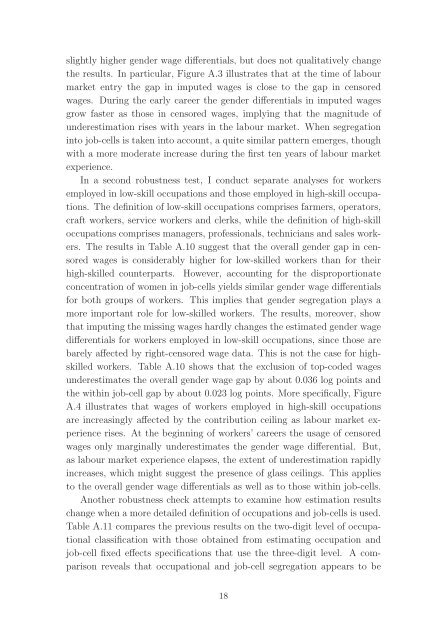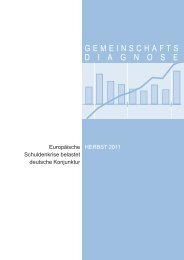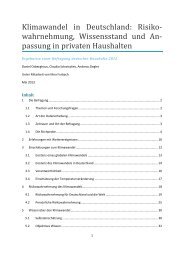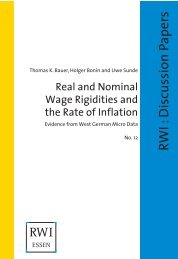Gender Segregation and Gender Wage Differences during the Early ...
Gender Segregation and Gender Wage Differences during the Early ...
Gender Segregation and Gender Wage Differences during the Early ...
You also want an ePaper? Increase the reach of your titles
YUMPU automatically turns print PDFs into web optimized ePapers that Google loves.
slightly higher gender wage differentials, but does not qualitatively change<br />
<strong>the</strong> results. In particular, Figure A.3 illustrates that at <strong>the</strong> time of labour<br />
market entry <strong>the</strong> gap in imputed wages is close to <strong>the</strong> gap in censored<br />
wages. During <strong>the</strong> early career <strong>the</strong> gender differentials in imputed wages<br />
grow faster as those in censored wages, implying that <strong>the</strong> magnitude of<br />
underestimation rises with years in <strong>the</strong> labour market. When segregation<br />
into job-cells is taken into account, a quite similar pattern emerges, though<br />
with a more moderate increase <strong>during</strong> <strong>the</strong> first ten years of labour market<br />
experience.<br />
In a second robustness test, I conduct separate analyses for workers<br />
employed in low-skill occupations <strong>and</strong> those employed in high-skill occupations.<br />
The definition of low-skill occupations comprises farmers, operators,<br />
craft workers, service workers <strong>and</strong> clerks, while <strong>the</strong> definition of high-skill<br />
occupations comprises managers, professionals, technicians <strong>and</strong> sales workers.<br />
The results in Table A.10 suggest that <strong>the</strong> overall gender gap in censored<br />
wages is considerably higher for low-skilled workers than for <strong>the</strong>ir<br />
high-skilled counterparts. However, accounting for <strong>the</strong> disproportionate<br />
concentration of women in job-cells yields similar gender wage differentials<br />
for both groups of workers. This implies that gender segregation plays a<br />
more important role for low-skilled workers. The results, moreover, show<br />
that imputing <strong>the</strong> missing wages hardly changes <strong>the</strong> estimated gender wage<br />
differentials for workers employed in low-skill occupations, since those are<br />
barely affected by right-censored wage data. This is not <strong>the</strong> case for highskilled<br />
workers. Table A.10 shows that <strong>the</strong> exclusion of top-coded wages<br />
underestimates <strong>the</strong> overall gender wage gap by about 0.036 log points <strong>and</strong><br />
<strong>the</strong> within job-cell gap by about 0.023 log points. More specifically, Figure<br />
A.4 illustrates that wages of workers employed in high-skill occupations<br />
are increasingly affected by <strong>the</strong> contribution ceiling as labour market experience<br />
rises. At <strong>the</strong> beginning of workers’ careers <strong>the</strong> usage of censored<br />
wages only marginally underestimates <strong>the</strong> gender wage differential. But,<br />
as labour market experience elapses, <strong>the</strong> extent of underestimation rapidly<br />
increases, which might suggest <strong>the</strong> presence of glass ceilings. This applies<br />
to <strong>the</strong> overall gender wage differentials as well as to those within job-cells.<br />
Ano<strong>the</strong>r robustness check attempts to examine how estimation results<br />
change when a more detailed definition of occupations <strong>and</strong> job-cells is used.<br />
Table A.11 compares <strong>the</strong> previous results on <strong>the</strong> two-digit level of occupational<br />
classification with those obtained from estimating occupation <strong>and</strong><br />
job-cell fixed effects specifications that use <strong>the</strong> three-digit level. A comparison<br />
reveals that occupational <strong>and</strong> job-cell segregation appears to be<br />
18
















